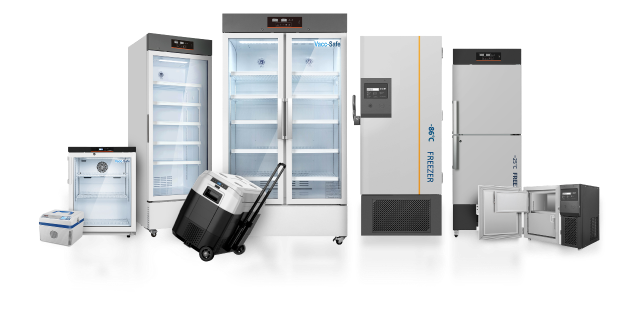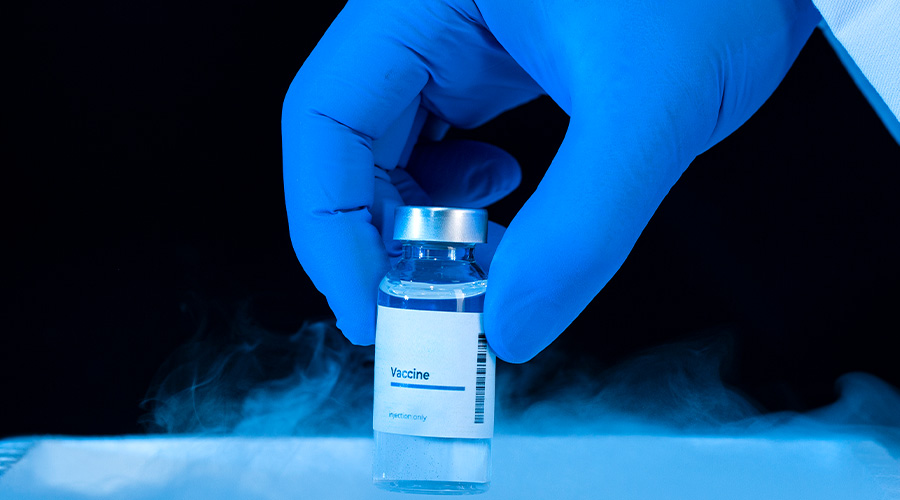
Why A Medical Fridge Needs To Be Serviced
May 6, 2025
Pharmacy Medicine Storage
June 12, 2025Correct storage practices are imperative for the safety and efficacy of vaccines. Vaccines must be stored in strict temperature guidelines, in a purpose built medical fridge, and arranged in a way that makes sure they are not exposed to harmful conditions. When vaccines are exposed to unfavourable conditions, they can lose efficacy and even become dangerous for patients. This article guides you through correct vaccine storage practices of temperature control, light protection, organised storage and why proper vaccine storage is crucial.
Correct storage practices are imperative for the safety and efficacy of vaccines. Vaccines must be stored in strict temperature guidelines, in a purpose built medical fridge, and arranged in a way that makes sure they are not exposed to harmful conditions. When vaccines are exposed to unfavourable conditions, they can lose efficacy and even become dangerous for patients. This article guides you through correct vaccine storage practices of temperature control, light protection, organised storage and why proper vaccine storage is crucial.
Where To Store Vaccines
Vaccines are temperature sensitive medications and must be stored in a purpose built medical fridge that provides strict temperature parameters between 2°C and 8°C. If stored outside these temperatures vaccines can quickly degrade and become ineffective. The system for storing temperature sensitive medications like vaccines is called the cold chain and it ensures that vaccines are manufactured, stored and handled in temperature controlled environments like medical refrigerators.
Types of Medical Fridges for Storing Vaccines
When storing vaccines, it is important to understand the types of medical fridges available and what industries may use them for this temperature sensitive medication. There are two main types of medical fridges for storing vaccines – purpose built vaccine refrigerators and portable purpose built vaccine storage fridges.
Purpose-Built Vaccine Refrigerators
Ideal for a pharmacy, veterinary clinic, and medical facility, purpose-built medical refrigerators are specific pieces of equipment that will be used for storing temperature sensitive vaccines. Purpose-built medical refrigerators for vaccines are available in a variety of styles and sizes. These include:
- Premium Refrigerator – Available in 350 litre to 1006 litre capacity, the Premium Refrigerator is ideal for pharmacies, veterinary clinics and medical facilities to store temperature sensitive vaccines. It has a strong cooling airflow from the top to the bottom, and works as an air curtain to block the external hot air from entering the refrigerator when the door is opened to prevent the temperature in the cabinet from rising rapidly.

- Underbench Refrigerator – Ideal for smaller practices to store vaccines, the underbench refrigerator is available in 50 litre and 150 litre capacity. This medical refrigerator is suitable for storing vaccines between 2°C and 8°C in pharmacies, hospitals, medical clinics and laboratories.

Purpose-Built Portable Vaccine Refrigerators
Vaccine storage guidelines state that vaccines must be stored in a cold chain with specific temperatures from manufacture and transportation to the pharmacy or medical facility. During transportation, purpose-built medical refrigerators were designed to be able to carry temperature sensitive vaccines from one facility to the next. This includes:
- Portable Refrigerator – This 6 litre capacity, active cooling portable medical refrigerator transports vaccines staying within the temperature parameters of 2°C and 6°C. These portable refrigerators are designed to be easily transported and often include castors, handles, and shoulder straps which makes it more convenient for moving from one place to another. Portable vaccine refrigerators are used in pharmacies, hospitals and veterinary clinics.

How To Maintain Temperature Control When Storing Vaccines
Maintaining temperature control is an important part of vaccine storage practices and there are a number of ways to do this. These include:
- Storing vaccines in a medical fridge that is designed to maintain strict temperature guidelines to avoid cold chain breaches.
- Monitoring the temperature by manually recording the minimum and maximum temperature of the refrigerator at least once a day.
- Using data loggers that automatically record and alert to any temperature fluctuations.
The Importance of Correct Vaccine Arrangement in a Fridge
Strict temperature controls within the guidelines are imperative for the safe storage of vaccines. However, how they are arranged in the fridge is just as important. These strategies are crucial for ensuring the fridge is properly organised to maintain an efficient cold chain supply.
Vaccine Placement
Where vaccines are placed in the fridge is important as space needs to be given to allow the cold air of the fridge to circulate. If you store your vaccines too closely together, the temperature of the vaccines on the outside will be colder than those stored near the middle of the fridge. To make sure vaccines are placed correctly:
- Store vaccines in the middle of the fridge away from the coils, walls and air vents.
- Group vaccines together. Keep the same vaccines together such as adult, child or adolescent types. This makes it easier to locate a vaccine, reducing the time the fridge door is open. It also helps with stock control, knowing if you’re low on a certain type of vaccine.
- Do not store vaccines in the door or on the floor as these areas have less stable temperatures.
- Keep a distance of 4-6 centimetres between rows of boxes, or trays, and between the vaccines and the sides of your fridge. This allows for refrigerated air to circulate and maintain a consistent temperature.
- Keep vaccines with shorter use by dates near the front of the fridge, so they are used first.
- Ensure you can shut the door. Do not over stock your fridge so the door does not close. If this occurs, look at getting another fridge or alternate storage.
- Keep the diluent and the corresponding vaccine together. The diluent is the liquid used to dilute the vaccine to the correct concentration immediately prior to use. This will help with keeping the door closed as you will not be searching for the diluent that goes with the vaccine.
Vaccine Packaging
There are two kinds of packaging available for vaccines when being stored in the fridge – the box they arrive in, and mesh trays once they’ve been taken out of the box. Do not keep vaccines in any other type of container when in the fridge.
- When you receive your vaccines from your supplier you must immediately store them in the fridge so you don’t break the ‘cold chain’, which is the system of transporting vaccines and maintaining the perfect, cold temperature.
- Check the boxes for any damage that may have occurred during transport. If you see a dented box, check the contents to ensure no vials have been broken. If you discover a broken vial, alert your supplier and follow Cold Chain Breach protocols.
- Keep vaccines in the original box until ready to use. Keeping vaccines yet to be used in their boxes helps organise your fridge and keep things neat and tidy. The newest boxes go to the rear, so you use vaccines in order of use by date.
- Place vaccines in breathable plastic baskets. When you’ve opened a box, transfer all vaccines into mesh baskets. This indicates the batch being used currently, and it is easier to read labels and view use by dates. Don’t leave half-full boxes of vaccines in a fridge.
- Keep loose vials in labelled trays. Loose vials can be stored, upright, in plastic mesh trays. Only keep vaccines of the same type in these trays. Do not mix and match, as this will lead to confusion, and more time spent with the fridge door open trying to find the right vaccine.
- Never keep loose vials stored outside of their box or a plastic mesh tray. Keeping them in a box or the mesh tray will reduce the likelihood of spillage or damage from rolling around..
Vaccine Labelling
Clear labelling of all your vaccines is essential for vaccine storage and arrangement. Vaccine labels must be easy to read and locate so the fridge door is open for as little time as possible. Clear labelling not only helps keep fridge temperatures regular, by decreasing the time a fridge door is open, but it also lessens the likelihood of administering the wrong vaccine. Follow these directions for labelling:
- Label the boxes and the shelves, and make sure the font size is large enough to be read easily by everyone.
- If your fridge doesn’t have a clear window door, place a storage chart on the door of the fridge and update it each time you use a vial of vaccine. This helps you determine which vaccine is on which shelf, so you can easily locate what you need. Understanding fridge contents and being able to locate them easily will reduce the amount of time the door is open and keep the temperature stable.
- When vaccines are opened, clearly mark the open date on the label. Some vaccines may have a long use by date, but this time will decrease once it has been opened and reconstituted. Clearly labelling with dates of reconstitution also helps with stock management.
Vaccine Protection from Light
Vaccines must be protected from the light. They lose potency if exposed to direct sunlight or ultraviolet light. To ensure vaccines are protected from the light:
- Store vaccines in a medical fridge.
- Make sure the medical fridge is not placed in direct sunlight that could impact the vaccines.
- Do not remove original vaccine packaging as it helps prevent exposure to sunlight or UV light.
Additional Tips for Storing and Arranging Vaccines
Here are some extra tips when storing vaccines in your medical fridge.
- If your fridge is mostly empty, storing water bottles on the floor of your fridge can help maintain a constantly cool temperature. These are not water bottles you drink from, as you should not store your food and beverages in the vaccine fridge.
- Keep the fridge closed as much as possible. Every time you open the fridge door the temperature fluctuates inside. If you do not have a fridge with a clear door, use a storage chart, and train staff on the importance of keeping the fridge door closed.
- Store freeze-sensitive vaccines away from the freezer vent inside the fridge. If you have a fridge-freezer combination, there is usually a vent in the fridge for freezer air to come in and cool. Some vaccines are freeze-sensitive, such as the Hepatitis B vaccine, and can possibly be ruined if stored too close to this vent.
- Make sure the medical fridge is serviced on a regular basis to ensure vaccines are safely stored at temperature control of 2°C to 8°C.
What Not To Do When Storing and Arranging Vaccines
- Do not store anything else in a medical fridge. Do not keep food or beverages in the vaccine fridge. This can impact the temperature and risk cross contamination.
- Do not place vaccines near cold air vents. Fridge-freezer units have a vent for cold air from the freezer to enter the fridge to help modulate temperature. This cold air can potentially drop the temperature of a vaccine to below recommended standards, and spoil the vaccine.
- Do not store vaccines in a regular refrigerator. If some medicines or medical materials are stored in an environment that is not strictly controlled, they will expire quickly, and possibly contaminate materials around them.
Why Proper Vaccine Arrangement is Important
Vaccine arrangement is important to ensure these temperature sensitive medications remain viable and safe for patients. Additional reasons vaccine arrangement is important include:
- Maintaining temperature uniformity and preventing fluctuations.
- Ensuring vaccine stability and efficacy.
- To be able to facilitate visual inspection.
- Reducing waste by making sure vaccines remain viable.
Vaccines are temperature sensitive medications that require specific temperatures and fridge arrangement to remain viable. To adhere to cold chain guidelines, they must be stored in a medical fridge. For any questions about storing and arranging vaccines in a fridge or the best type of medical fridge for your vaccines, contact the team at Vaccsafe.
Correct storage practices are imperative for the safety and efficacy of vaccines. Vaccines must be stored in strict temperature guidelines, in a purpose built medical fridge, and arranged in a way that makes sure they are not exposed to harmful conditions. When vaccines are exposed to unfavourable conditions, they can lose efficacy and even become dangerous for patients. This article guides you through correct vaccine storage practices of temperature control, light protection, organised storage and why proper vaccine storage is crucial.
Where To Store Vaccines
Vaccines are temperature sensitive medications and must be stored in a purpose built medical fridge that provides strict temperature parameters between 2°C and 8°C. If stored outside these temperatures vaccines can quickly degrade and become ineffective. The system for storing temperature sensitive medications like vaccines is called the cold chain and it ensures that vaccines are manufactured, stored and handled in temperature controlled environments like medical refrigerators.
Types of Medical Fridges for Storing Vaccines
When storing vaccines, it is important to understand the types of medical fridges available and what industries may use them for this temperature sensitive medication. There are two main types of medical fridges for storing vaccines – purpose built vaccine refrigerators and portable purpose built vaccine storage fridges.
Purpose-Built Vaccine Refrigerators
Ideal for a pharmacy, veterinary clinic, and medical facility, purpose-built medical refrigerators are specific pieces of equipment that will be used for storing temperature sensitive vaccines. Purpose-built medical refrigerators for vaccines are available in a variety of styles and sizes. These include:
- Premium Refrigerator – Available in 350 litre to 1006 litre capacity, the Premium Refrigerator is ideal for pharmacies, veterinary clinics and medical facilities to store temperature sensitive vaccines. It has a strong cooling airflow from the top to the bottom, and works as an air curtain to block the external hot air from entering the refrigerator when the door is opened to prevent the temperature in the cabinet from rising rapidly.

- Underbench Refrigerator – Ideal for smaller practices to store vaccines, the underbench refrigerator is available in 50 litre and 150 litre capacity. This medical refrigerator is suitable for storing vaccines between 2°C and 8°C in pharmacies, hospitals, medical clinics and laboratories.

Purpose-Built Portable Vaccine Refrigerators
Vaccine storage guidelines state that vaccines must be stored in a cold chain with specific temperatures from manufacture and transportation to the pharmacy or medical facility. During transportation, purpose-built medical refrigerators were designed to be able to carry temperature sensitive vaccines from one facility to the next. This includes:
- Portable Refrigerator – This 6 litre capacity, active cooling portable medical refrigerator transports vaccines staying within the temperature parameters of 2°C and 6°C. These portable refrigerators are designed to be easily transported and often include castors, handles, and shoulder straps which makes it more convenient for moving from one place to another. Portable vaccine refrigerators are used in pharmacies, hospitals and veterinary clinics.

How To Maintain Temperature Control When Storing Vaccines
Maintaining temperature control is an important part of vaccine storage practices and there are a number of ways to do this. These include:
- Storing vaccines in a medical fridge that is designed to maintain strict temperature guidelines to avoid cold chain breaches.
- Monitoring the temperature by manually recording the minimum and maximum temperature of the refrigerator at least once a day.
- Using data loggers that automatically record and alert to any temperature fluctuations.
The Importance of Correct Vaccine Arrangement in a Fridge
Strict temperature controls within the guidelines are imperative for the safe storage of vaccines. However, how they are arranged in the fridge is just as important. These strategies are crucial for ensuring the fridge is properly organised to maintain an efficient cold chain supply.
Vaccine Placement
Where vaccines are placed in the fridge is important as space needs to be given to allow the cold air of the fridge to circulate. If you store your vaccines too closely together, the temperature of the vaccines on the outside will be colder than those stored near the middle of the fridge. To make sure vaccines are placed correctly:
- Store vaccines in the middle of the fridge away from the coils, walls and air vents.
- Group vaccines together. Keep the same vaccines together such as adult, child or adolescent types. This makes it easier to locate a vaccine, reducing the time the fridge door is open. It also helps with stock control, knowing if you’re low on a certain type of vaccine.
- Do not store vaccines in the door or on the floor as these areas have less stable temperatures.
- Keep a distance of 4-6 centimetres between rows of boxes, or trays, and between the vaccines and the sides of your fridge. This allows for refrigerated air to circulate and maintain a consistent temperature.
- Keep vaccines with shorter use by dates near the front of the fridge, so they are used first.
- Ensure you can shut the door. Do not over stock your fridge so the door does not close. If this occurs, look at getting another fridge or alternate storage.
- Keep the diluent and the corresponding vaccine together. The diluent is the liquid used to dilute the vaccine to the correct concentration immediately prior to use. This will help with keeping the door closed as you will not be searching for the diluent that goes with the vaccine.
Vaccine Packaging
There are two kinds of packaging available for vaccines when being stored in the fridge – the box they arrive in, and mesh trays once they’ve been taken out of the box. Do not keep vaccines in any other type of container when in the fridge.
- When you receive your vaccines from your supplier you must immediately store them in the fridge so you don’t break the ‘cold chain’, which is the system of transporting vaccines and maintaining the perfect, cold temperature.
- Check the boxes for any damage that may have occurred during transport. If you see a dented box, check the contents to ensure no vials have been broken. If you discover a broken vial, alert your supplier and follow Cold Chain Breach protocols.
- Keep vaccines in the original box until ready to use. Keeping vaccines yet to be used in their boxes helps organise your fridge and keep things neat and tidy. The newest boxes go to the rear, so you use vaccines in order of use by date.
- Place vaccines in breathable plastic baskets. When you’ve opened a box, transfer all vaccines into mesh baskets. This indicates the batch being used currently, and it is easier to read labels and view use by dates. Don’t leave half-full boxes of vaccines in a fridge.
- Keep loose vials in labelled trays. Loose vials can be stored, upright, in plastic mesh trays. Only keep vaccines of the same type in these trays. Do not mix and match, as this will lead to confusion, and more time spent with the fridge door open trying to find the right vaccine.
- Never keep loose vials stored outside of their box or a plastic mesh tray. Keeping them in a box or the mesh tray will reduce the likelihood of spillage or damage from rolling around..
Vaccine Labelling
Clear labelling of all your vaccines is essential for vaccine storage and arrangement. Vaccine labels must be easy to read and locate so the fridge door is open for as little time as possible. Clear labelling not only helps keep fridge temperatures regular, by decreasing the time a fridge door is open, but it also lessens the likelihood of administering the wrong vaccine. Follow these directions for labelling:
- Label the boxes and the shelves, and make sure the font size is large enough to be read easily by everyone.
- If your fridge doesn’t have a clear window door, place a storage chart on the door of the fridge and update it each time you use a vial of vaccine. This helps you determine which vaccine is on which shelf, so you can easily locate what you need. Understanding fridge contents and being able to locate them easily will reduce the amount of time the door is open and keep the temperature stable.
- When vaccines are opened, clearly mark the open date on the label. Some vaccines may have a long use by date, but this time will decrease once it has been opened and reconstituted. Clearly labelling with dates of reconstitution also helps with stock management.
Vaccine Protection from Light
Vaccines must be protected from the light. They lose potency if exposed to direct sunlight or ultraviolet light. To ensure vaccines are protected from the light:
- Store vaccines in a medical fridge.
- Make sure the medical fridge is not placed in direct sunlight that could impact the vaccines.
- Do not remove original vaccine packaging as it helps prevent exposure to sunlight or UV light.
Additional Tips for Storing and Arranging Vaccines
Here are some extra tips when storing vaccines in your medical fridge.
- If your fridge is mostly empty, storing water bottles on the floor of your fridge can help maintain a constantly cool temperature. These are not water bottles you drink from, as you should not store your food and beverages in the vaccine fridge.
- Keep the fridge closed as much as possible. Every time you open the fridge door the temperature fluctuates inside. If you do not have a fridge with a clear door, use a storage chart, and train staff on the importance of keeping the fridge door closed.
- Store freeze-sensitive vaccines away from the freezer vent inside the fridge. If you have a fridge-freezer combination, there is usually a vent in the fridge for freezer air to come in and cool. Some vaccines are freeze-sensitive, such as the Hepatitis B vaccine, and can possibly be ruined if stored too close to this vent.
- Make sure the medical fridge is serviced on a regular basis to ensure vaccines are safely stored at temperature control of 2°C to 8°C.
What Not To Do When Storing and Arranging Vaccines
- Do not store anything else in a medical fridge. Do not keep food or beverages in the vaccine fridge. This can impact the temperature and risk cross contamination.
- Do not place vaccines near cold air vents. Fridge-freezer units have a vent for cold air from the freezer to enter the fridge to help modulate temperature. This cold air can potentially drop the temperature of a vaccine to below recommended standards, and spoil the vaccine.
- Do not store vaccines in a regular refrigerator. If some medicines or medical materials are stored in an environment that is not strictly controlled, they will expire quickly, and possibly contaminate materials around them.
Why Proper Vaccine Arrangement is Important
Vaccine arrangement is important to ensure these temperature sensitive medications remain viable and safe for patients. Additional reasons vaccine arrangement is important include:
- Maintaining temperature uniformity and preventing fluctuations.
- Ensuring vaccine stability and efficacy.
- To be able to facilitate visual inspection.
- Reducing waste by making sure vaccines remain viable.
Vaccines are temperature sensitive medications that require specific temperatures and fridge arrangement to remain viable. To adhere to cold chain guidelines, they must be stored in a medical fridge. For any questions about storing and arranging vaccines in a fridge or the best type of medical fridge for your vaccines, contact the team at Vaccsafe.





